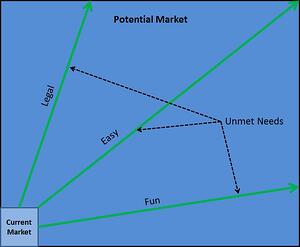If you have $1M to invest, in which of the following two opportunities would you invest?
Opportunity 1
This is a consumer electronics product. Currently your business doesn’t have any offerings in this product category. The business case for this opportunity includes these numbers:
| Size of the opportunity | 600K units @ $250 ($150M total) |
| Growth rate of the opportunity | ~ 12% per year |
| Competition | Sony, Samsung, and Ericson have established offerings |
| Expected Profitability | Millions of dollars of investment so far and all losing money |
Opportunity 2
This is a consumer product. Currently your business doesn’t have any offerings in this product category. The business case for this opportunity includes these numbers:
| Size of the opportunity | > $68B |
| Growth rate of the opportunity | ~ 11% per year |
| Competition | Fragmented (> 40K competitors with largest < 2% share) |
| Expected Profitability | Gross margins > 60% |
From a traditional market analysis perspective, Opportunity 2 looks much more attractive. It is a large and growing market. Fragmented competition usually means that there is opportunity for consolidation and brand development. And gross margins more than 60% sound very appealing.
On the other hand, Opportunity 1 is relatively small from a consumer electronics perspective and at a 12% growth rate, it isn’t going to get large anytime soon. The competition consists of very strong global consumer electronics players and they are all struggling to make money. No one in their right mind would choose Opportunity 1 over Opportunity 2, right?
Now consider the fact that Opportunity 1 is actually a view of the MP3 market in 1999 and Opportunity 2 is a view of the retail jewelry market in 2012. I’m sure everyone remembers what happened to the MP3 market in 2000: Apple launched the iPod. In fact, Apple has brought in more than $125 billion in revenue from devices that have evolved from the original iPod, and the net earnings are now larger than the sales revenue from everything else.
On the other hand, jewelry stores today have very high working capital costs, very high operating costs, very low net profit margins, and high failure rates. No one has been successful in trying to consolidate this market and online shopping is continuing to erode margins.
 So, what did Apple see that wasn’t apparent in the analysis above? First of all, they saw a set of unmet needs in the market. Back in 1999, there were a few fundamental issues in the MP3 market. First, it was very difficult to get the music onto any device. If the consumer wanted to take the high road, he had to copy the music off of a CD and onto a computer (provided you had the right hardware to do that). Next, he had to convert the music files from .wav format to .mp3 format (which required software and some technical savvy). Then he had to copy the music from his computer onto the MP3 device. The more likely scenario was that you used a music sharing service, such as Napster to get songs in .mp3 format, which was illegal. Thus, in the end for the typical consumer there was a need for a legal, easy, and fun way to have portable music.
So, what did Apple see that wasn’t apparent in the analysis above? First of all, they saw a set of unmet needs in the market. Back in 1999, there were a few fundamental issues in the MP3 market. First, it was very difficult to get the music onto any device. If the consumer wanted to take the high road, he had to copy the music off of a CD and onto a computer (provided you had the right hardware to do that). Next, he had to convert the music files from .wav format to .mp3 format (which required software and some technical savvy). Then he had to copy the music from his computer onto the MP3 device. The more likely scenario was that you used a music sharing service, such as Napster to get songs in .mp3 format, which was illegal. Thus, in the end for the typical consumer there was a need for a legal, easy, and fun way to have portable music.
The problem wasn’t the MP3 devices; the problem was the music-delivery mechanism. Apple really didn’t attempt to compete with the other MP3 manufacturers on a feature basis. Instead, they opened up an entire portion of the market that wasn’t available to the other MP3 manufacturers by providing iTunes.
In order to properly evaluate the business case for an opportunity, you must first understand the dynamics of the market, identify if there are unmet needs, look for ways to create sustainable differentiation by addressing those unmet needs, and then look at the potential size of the opportunity and potential profitability. Looking in the rearview mirror at the current market and competitors to determine your business strategy will at best set you up to be a little late to market with a product that is almost as good as the current competitors’ products with a higher cost structure, which is a sure recipe for failure.
For more insight about creating a compelling business case and quantifying value propositions, subscribe to our blog -- we feature a new post every Tuesday.







